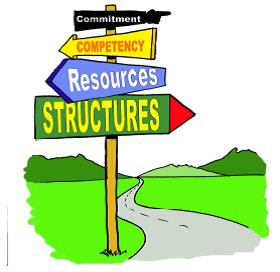The key areas for action to improve your business
Author: Neville Brady (Bunch Consulting) | Date: 08 Sep 2015
Take home messages
- Improving business outcomes is largely dependent on improving our structures, resources, competencies and commitment.
- To reduce your ‘tail’ you need to improve one of, or a combination of the four key causes for underperformance.
Business outcome improvement
Improving business outcomes is largely dependent on improving business inputs, which means improving our structures, resources, competencies and commitment.
Structures – the rules and objectives of our game
Objectives, culture, values, systems, standards, job roles, expectations, reporting procedures, KPI’s, performance management practices, etc.
Resources – the tools we need to play our game
Templates, vehicles, peers (a great and under-utilised resource), stock, capital, tools, etc.
Competencies – the skills and knowledge which allow us to play our game
Commitment – our ambition or want to do
Playing our game according to our structures and expectations. Taking responsibility and making it easier for the next person.

Figure 1: The four business inputs.
Tail Management
To reduce your ‘tail’ you need to improve one of, or a combination of these four root causes for underperformance.
Behaviour/attitude change
As a general rule if you want a change in staffs’ behavior/attitudes, then you need a systemic or structural change.
An example of this is getting staff to report to their group on their areas of responsibility. This changes expectations and a procedure (structure).
Staff empowerment/competency/commitment
Collaborative problem solving and decision-making increases staff morale and motivation.
If we want to increase the accountability and responsibility of staff then we need to allow them to have input into the improvement of work practices.
Challenging staff to develop their solutions could be a mechanism to improve outcomes.
Skill development – a process to ensure that we’re good teachers
Show them the task without verbal instructions.
Show them again, but this time with verbal instructions.
Get them to do the task as you give them verbal instructions.
Get them to do the task as they explain to you what they’re doing.
Telling and showing them once isn’t enough.
Leadership tips
- To improve competency and commitment stop leading with answers. Lead with questions!
- Don’t adopt a parent/child approach to leading others.
- View your staff as managers. They need to manage their part of the business.
- Ensure staff understand their roles and the outcomes they’re expected to achieve and get them to report to their group.
- We can’t demand what we don’t demonstrate.
- Be a positive mood setter. Leaders’ moods are contagious. We sneeze, staff catch a cold.
- It’s our fault. When we point fault at others remember that there’s three fingers pointing back to us.
- Delegate. What low complexity tasks are we completing which we could delegate to others.
- Have regular bakery chats with our staff. Talk to them about what you’d like them to stop doing / start dong and keep doing.
- Ask staff what they’d like us to stop doing / start doing and keep doing.
Contact details
Neville Brady
Bunch Consulting
nbrady@bigpond.net.au
Was this page helpful?
YOUR FEEDBACK
